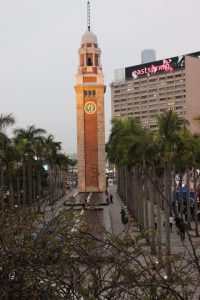We awoke around 7:30 a.m. to sub-tropical rainforest, which is not as dense as that at the Equator, isolated farms, terraced fields and tree covered pyramidal-like mountains. We were about 20 degrees north and the cloud and humid air clung to the mountain tops as well as in places almost at ground level.
Yesterday whilst running parallel to the 107 we saw the entrance to settlements marked by a stone monolith with the settlements name emblazoned upon it. This morning we found the ‘rock centres’ where it is possible to choose the size and rock type for your monolith!
Where there was construction work there were deep pools of mud and near every settlement the ‘tanks’ (man made lakes like those of India and Pakistan) that stored water and acted as fish farms for, especially, the smaller communities.
During the night we had crossed the Yangtze River near the city of Wuhan. This enters the Pacific Ocean near Shanghai. We crossed the Tropic of Cancer just before we reached Guangzhou at 10:00 a.m. The weather improved to a humid 16 C by the time we arrived in another dedicated part of the railway station in Kowloon on mainland Hong Kong.
A quick taxi ride got us to our hotel at the ‘posh end’ of Nathan Road, also known as ‘The Golden Mile’. We may be in part of China but the local currency is the Hong Kong dollar and later this afternoon we will have to get some.
This evening before dinner we walked to see Victoria Harbour being illuminated by the high-rise buildings. We stood close to the ferry terminal that carries people from Kowloon to Hong Kong Island and close to the clock tower which is the last remnant of the 1915 railway terminus. This was the last stop on the Orient Express and a wonderful way of ending our railway adventure.
We would like to thank Real Russia in London who took our ideas for this expedition and enabled us to complete this with their outstanding help and organisation of the railway journeys. Other things we did ourselves. Everything has worked like clockwork and their specialist expertise has enabled us to cope with and cut through the red tape of intercontinental travel.
We still have 2 more days to explore Hong Kong before returning on another adventure on an Airbus A380, the world’s largest passenger aeroplane, to Manchester.






















